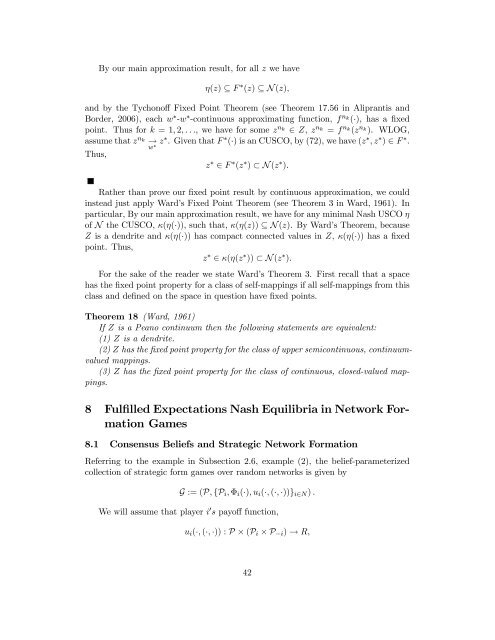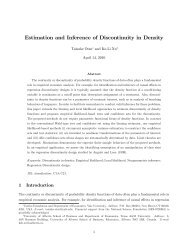By our main approximation result, for all z we haveη(z) ⊆ F ∗ (z) ⊆ N (z),<strong>and</strong> by the Tychonoff <strong>Fixed</strong> Point Theorem (see Theorem 17.56 in Aliprantis <strong>and</strong>Border, 2006), each w ∗ -w ∗ -continuous approximating function, f n k(·), hasafixedpoint. Thus for k =1, 2,...,wehaveforsomez n k∈ Z, z n k= f n k(z n k). WLOG,assume that z n k→ z∗ .GiventhatF ∗ (·) is an CUSCO, by (72), we have (z ∗ ,z ∗ ) ∈ F ∗ .w ∗Thus,z ∗ ∈ F ∗ (z ∗ ) ⊂ N (z ∗ ).Rather than prove our fixed point result by continuous approximation, we couldinstead just apply Ward’s <strong>Fixed</strong> Point Theorem (see Theorem 3 in Ward, 1961). Inparticular, By our main approximation result, we have for any minimal Nash USCO ηof N the CUSCO, κ(η(·)), such that, κ(η(z)) ⊆ N (z). By Ward’s Theorem, becauseZ is a dendrite <strong>and</strong> κ(η(·)) has compact connected values in Z, κ(η(·)) has a fixedpoint. Thus,z ∗ ∈ κ(η(z ∗ )) ⊂ N (z ∗ ).For the sake of the reader we state Ward’s Theorem 3. First recall that a spacehas the fixed point property for a class of self-mappings if all self-mappings from thisclass <strong>and</strong> defined on the space in question have fixed points.Theorem 18 (Ward, 1961)If Z is a Peano continuum then the following statements are equivalent:(1) Z is a dendrite.(2) Z has the fixed point property for the class of upper semicontinuous, continuumvaluedmappings.(3) Z has the fixed point property for the class of continuous, closed-valued mappings.8 Fulfilled Expectations Nash Equilibria in Network FormationGames8.1 Consensus Beliefs <strong>and</strong> Strategic Network FormationReferring to the example in Subsection 2.6, example (2), the belief-parameterizedcollection of strategic form games over r<strong>and</strong>om networks is given byG := (P, {P i , Φ i (·),u i (·, (·, ·))} i∈N ) .We will assume that player i 0 s payoff function,u i (·, (·, ·)) : P×(P i ×P −i ) → R,42
is given byu i (μ e , (μ i , μ −i )) := R G + iRG + −iv i (g + i ,g+ −i )dμ i(g + i )dμe −i (g+ −i ),wherev i (·, ·) :G + i× G + −i → R,is continuous on G + i× G + −i . Note that because v i(·, ·) is h K -continuous on G + i× G + −i ,u i (·, (·, ·)) is w ∗ -continuous on P×(P i×P −i ),<strong>and</strong>foreach(μ e , μ −i ) ∈ P×P −i ,u i (μ e , (·, μ −i )) is affine on P i . Thus, under consensus beliefs μ e ∈ P, playeri 0 s payoffunder r<strong>and</strong>om sender network strategy profile μ := (μ i , μ −i ) ∈ P is u i (μ e , (μ i , μ −i )).8.2 Fulfilled Expectations Nash Equilibria in a Belief-ParameterizedCollection Network Formation GamesGiven consensus beliefs μ e , μ e -game, G μ e := {Φ i (μ e −i ),u i(μ e , (·, ·))} i∈N ,foreachμ eG μ e has a nonempty set of Nash equilibria given byoN (μ e ):=nμ ∗ ∈ P : ∀i, u i (μ e , (μ ∗ i , μ∗ −i )) := max μ i ∈Φ i (μ e −i ) u i (μ e , (μ i , μ ∗ −i )) .The parameterized collection of network formation games,G := (P, {P i , Φ i (·),u i (·, (·, ·))} i∈N ) ,has a fulfilled expectations Nash equilibria if the Nash USCO, N (·)), hasfixed points.8.3 ExistenceConsider the collection of μ e -games, {G μ e : μ e ∈ P}, where for each profile of consensusbeliefs, μ e ∈ P, G μ e is given byG μ e := {P i , Φ i (μ e ),u i (μ e , (·, ·))} i∈N.This game has Nikaido-Isoda function given byϕ(μ e , (σ, μ)):= U μ e(σ, μ) − U μ e(μ, μ):= P i u i(μ e , (σ i , μ −i )) − P i u i(μ e , (μ i , μ −i )).Our belief-parameterized collection network formation games, {G μ e : μ e ∈ P} withexternalities over r<strong>and</strong>om networks is easily seen to satisfy assumptions [A-1]. Thus,by our fixed point theorem, the Nash correspondence, μ → N (μ), hasafixed point,μ ∗ ∈ N (μ ∗ ),whereμ ∗ is a fulfilled expectations Nash equilibrium r<strong>and</strong>om network.43
- Page 5: cally approximated by continuous fu
- Page 12 and 13: the set x 0 x 1 ∈ C w ∗ f(X) is
- Page 14 and 15: defined on some probability space,
- Page 16 and 17: contains at most one arc (i.e., ¯
- Page 18 and 19: into the collection of Ky Fan sets
- Page 20 and 21: 3.1 Best Response MappingsLetting p
- Page 22 and 23: 4.1 Nikaido-Isoda FunctionsWith eac
- Page 24 and 25: Because Φ(z) × Φ(z) is w ∗ ×
- Page 26 and 27: where for all n, C n ∈ S E n,then
- Page 28 and 29: Definition 4 (The 3M Property - The
- Page 30 and 31: Given (48) and the fact that for n
- Page 32 and 33: We note that if m(z) ∈ P w ∗ f(
- Page 34 and 35: 6.3 AK Convergence of Minimal Nash
- Page 36 and 37: and Gr ρZ ×w ∗f ∗ (·) is the
- Page 38 and 39: In particular, for all n ≥ N 0 an
- Page 40 and 41: the cutting defined by the cut poin
- Page 42 and 43: According to our main result, under
- Page 46 and 47: 9 Appendix 1: USCO FundamentalsIn t
- Page 48 and 49: 9.3 Equi-QuasicontinuityIn order to
- Page 50 and 51: 9.5 Dense SelectionsFor each F ∈
- Page 52 and 53: 10 Appendix 2: The Proof of Lemma 8
- Page 54 and 55: Noting that if E ∈ D eE ,thenn eE
- Page 56 and 57: 12 Appendix 4: The Proof That All K
- Page 58 and 59: Letting E 1 =[E 1 \(X × U 2 )] ∪
- Page 60 and 61: [10] Bryant, V. W. (1970) “The Co
- Page 62: [42] Ward, L. E., Jr. (1958) “A F






